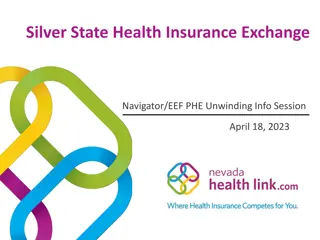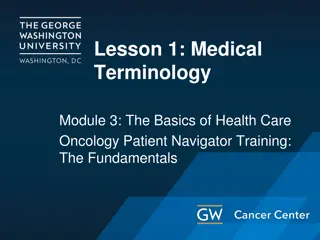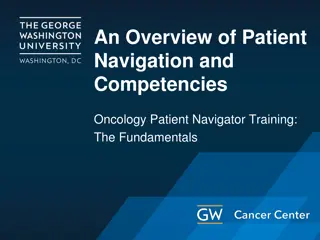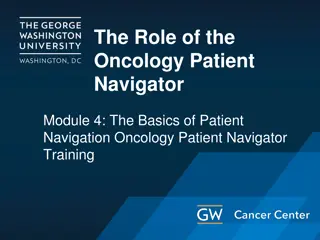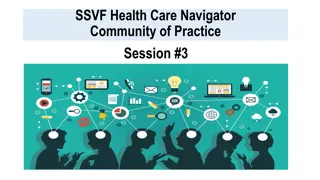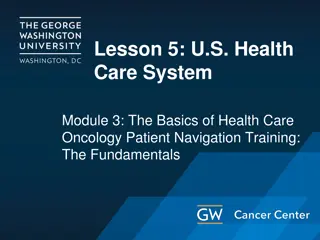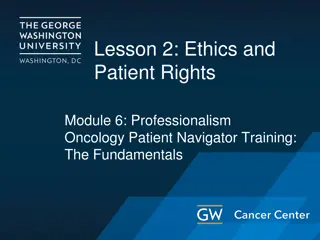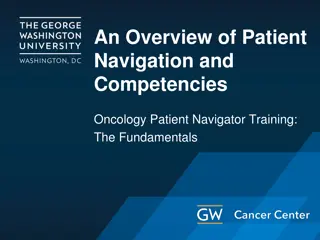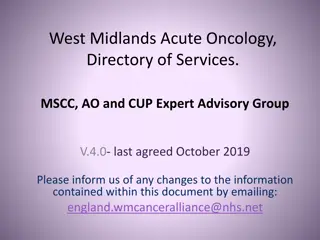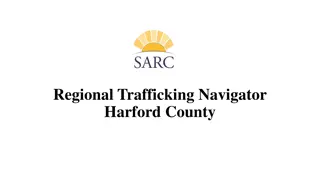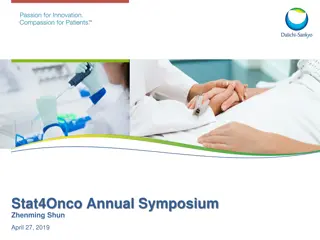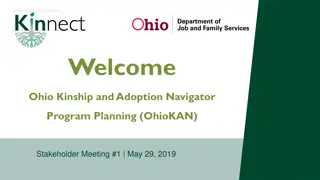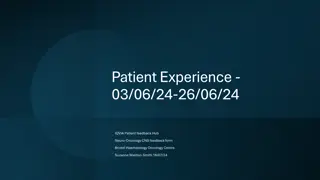Enhancing Practice Oncology Patient Navigator Training
This module focuses on Program Evaluation and Quality Improvement for Patient Navigators in oncology, covering competencies, learning objectives, definitions, and reasons for evaluation. It emphasizes the importance of evaluating programs to improve effectiveness, secure funding, meet accreditation requirements, and communicate value to stakeholders.
Download Presentation

Please find below an Image/Link to download the presentation.
The content on the website is provided AS IS for your information and personal use only. It may not be sold, licensed, or shared on other websites without obtaining consent from the author. Download presentation by click this link. If you encounter any issues during the download, it is possible that the publisher has removed the file from their server.
E N D
Presentation Transcript
Lesson 3: Program Evaluation and Quality Improvement Module 7: Enhancing Practice Oncology Patient Navigator Training: The Fundamentals
Acknowledgments This work was supported by Cooperative Agreement #1U38DP004972-02 from the Centers for Disease Control and Prevention. Its contents are solely the responsibility of the authors and do not necessarily represent the official views of the Centers for Disease Control and Prevention. Portions of this lesson have been adapted with permission from the Patient Navigator Training Collaborative of the Colorado School of Public Health.
Competencies 3.1 Contribute to patient navigation program development, implementation and evaluation 3.2 Use evaluation data (barriers to care, patient encounters, resource provision, population health disparities and quality indicators) to collaboratively improve navigation process and participate in quality improvement 3.6 Maintain comprehensive, timely and legible records capturing ongoing patient barriers, patient interactions, barrier resolution and other evaluation metrics and report data to show value to administrators and funders 3.7 Promote navigation role, responsibilities and value to patients, providers and the larger community
Learning Objectives Describe the importance of program evaluation Describe potential roles for the patient navigator in evaluating programs Identify opportunities for quality improvement based on metrics Identify and implement strategies for quality improvement Describe value of patient navigation to different stakeholders Summarize patient navigation role and responsibility to different stakeholders
Definitions Program A program is a group of resources and activities used together to fulfill one or more purposes Program Evaluation The systematic collection and analysis of information about some or all aspects of a program to guide judgments or decisions Organizations, groups or individuals who have the power to influence your program, a political interest in your program, or would be impacted by your program s evaluation or outcomes Stakeholders Source: Newcomer, Hatry & Wholey, 2010.
Reasons to Evaluate Improve the program Say if the program works Find additional funding Report to funder Describe what you do Meet accreditation requirements Source: Patient Navigator Training Collaborative, n.d.
Commission on Cancer Community Needs Assessment Standard Establish a patient navigation process that provides resources onsite or through a community organization to overcome barriers to cancer care Modify the patient navigation process to address newly identified barriers to care Conduct a community needs assessment at least once during the 3- year survey cycle Evaluate the patient navigation process each year Source: Commission on Cancer, 2014.
Community Needs Assessment Cancer committee defines the scope of the needs assessment and must be involved in the design & evaluation Encouraged to work with outreach & marketing at cancer centers as well as community-based organizations outside the facility One system-wide barrier that will have the largest impact on patients is selected each year for improvement A new system-wide barrier must be selected each year Source: Commission on Cancer, 2014.
Questions that Program Evaluation Answers Should we continue the program? Did we reach our program goals? What evidence demonstrates that our administrators, funders, etc., should continue to support and fund the program? What can be changed to make the program more effective and improve outcomes? Source: Patient Navigator Training Collaborative, n.d.
When Should Evaluation Occur? Phase 1 Phase 2 Phase 3 Program Planning Implementation Outcomes Develop or modify activities What is expected to change? Implement Activities Assess Plan Process Evaluation Outcome Evaluation Formative Evaluation
Patient Navigators Role in Program Evaluation Data Collection Data Collection Data Analysis Data Analysis Data Reporting Who are your patients? What are the trends? Report for stakeholders What services are you providing? Where are the areas for improvement? Presentations How well are you assisting your patients? How long do certain tasks take? Source: Patient Navigator Training Collaborative, n.d.
Determine Evaluation Methods: Data Sources Where can we find the information? Patient records Cancer registry database Tracking logs Administrative data Meeting summaries Interview transcripts; notes Survey results
Determine Evaluation Methods: Data Collection How can we obtain the information? Patient records abstraction Surveys/questionnaires Interviews Review of tracking logs Focus groups Data Analysis: quantitative and/or qualitative
Formative Evaluation What might work to meet the need? Who would benefit from our program? How great is the need? Or what is the problem? How might we deliver the program activities? Should we pilot test or refine the program? Remember, formative evaluation happens during the building and planning process
Data Sources for Community Needs Assessment Surveillance, Epidemiology and End Results (SEER) Comprehensive Cancer Control Plans CDC/NCI State Cancer Profiles Your own program evaluation HealthyPeople 2020
Process Evaluation What was done? How was the program implemented? How well was the program implemented? Was the program implemented as planned? How satisfied are patients or providers with the program? How can we demonstrate program implementation even before outcomes have been attained?
Navigation Process Measures Measure Example Who provides the services Data Source Descriptive data Types of services provided Tracking log # of patients navigated Tracking log # of patient barriers Tracking log # of barriers resolved Tracking log # patient receiving co-pay assistance due to navigation Tracking log Communication between navigator and patients Patient surveys Patient satisfaction Patient surveys
Sample Demographic Form Available free of charge here.
PN-BOT is available free of charge here.
Sample Data 3500 2860 3000 2442 2500 2000 1631 1500 1140 1112 1096 995 919 887 1000 330 500 298 274 179 128 118 0
Outcomes Evaluation Outcome: The change(s) that your program will bring in your target population or social condition (not the program itself). Did we reach our program goals? How did the program impact the patient? What evidence demonstrates that our administrators, funders, etc. should continue to support and fund the program?
Navigation Outcome Measures Measure Example Data Source Time from screening to diagnostic resolution Medical record abstraction Tracking log Time from diagnosis to treatment Medical record abstraction Tracking log Patient adherence to scheduled appointments Medical record abstraction Medical Outcomes Study Adherence Survey National Cancer Institute Patient Experience Survey Patient satisfaction with navigation Patient reported outcomes: fatigue, distress, pain, quality of life, functionality FACT-C PROMIS
Navigation Outcome Measure Patient Experience Survey for Cancer FACT-C PROMIS
Tracking Data Keep your own records Use technology Track consistently and regularly Ensure data accuracy Ensure legibility
Case Study Scenario A Scenario B Struggle to find data Submit 2 patient stories No numbers included Easily finds numbers Shows outcomes Includes patient stories
Q/PI Tools Understanding the problem Patient Flow/Process Map Planning for change PDCA (PDSA)
Q/PI Tools: Patient Flow/ Process Map How many times is the patient passed from one person to another (hand-off)? Where are the bottlenecks? What is the approximate time taken for each step (task time)? How many steps are there for the patient? Are there things that are done more than once? Where are delays, queues and waiting built into the process? What are the longest delays? What is the approximate time between each step (wait time)? How many steps add no value for the patient? Where are the problems for the patients? Source: Understanding the Patient Journey-Process Mapping, n.d.
Q/PI Tools: Patient Flow How long does it take for patients to start treatment? How many miss appointments and why? What administrative barriers do the they face? How long does it take for patients to get test results? What are the biggest barriers? Screening Treatment Diagnosis Post- Treatment How long does it take to get to diagnosis? When do PN meet patients? What support or info do patients need at diagnosis? Who helps transition the patient to survivorship? What informational needs do patients have? What resources are available?
Q/PI Tools: PDCA Plan Act Do Check/Study Source: American Society for Quality, n.d.
The Value of the Patient Navigator Patients may see you as independent of the health care system Strong alliance with patients Solid knowledge of health care system Clear intentions to get to know the patient Offer patient personalized assistance Facilitate care coordination Meditate miscommunications between patients and providers Source: Carroll et al, 2010.
Checkpoint True or False: Coming up with a single statement that describes your role is better than tailoring your statements to match your audience.
Demonstrating Value to Stakeholders Internal stakeholders External stakeholders Administration Funders Clinicians Partners Navigators Patients Source: Wilcox & Bruce, 2010.
Tips for Crafting an Elevator Pitch Keep it short and simple Should generate excitement Be compelling Include the value added to stakeholder Know your audience Have an action item at the end Practice!
Value to Stakeholders Providers Reduce no-shows/missed appointments Adherence to treatment Assist with nonclinical issues (administrative, financial and practical) Free up their time to address clinical issues
Conclusion In this lesson you learned to: Describe the importance of program evaluation Describe potential roles for the patient navigator in evaluating programs Identify opportunities for quality improvement based on metrics Identify and implement strategies for quality improvement Describe value of patient navigation to different stakeholders Summarize patient navigation role and responsibility to different stakeholders
References American Society for Quality. (n.d). Plan Do Check Act (PDCA) cycle. http://asq.org/learn about quality/project planning tools/overview/pdca cycle.html. Carroll, J. K., Humiston, S. G., Meldrum, S. C., Salamone, C. M., Jean-Pierre, P., Epstein, R. M., & Fiscella, K. (2012). Patients' experiences with navigation for cancer care. Patient Education and Counseling, 80(2):241 247. doi: 10.1016/j.pec.2009.10.024. Commission on Cancer. (2014). American College of Surgeons: Accreditation Committee Clarifications for Standards 3.1 Patient Navigation Process and 3.2 Psychosocial Distress Screening. http://www.facs.org/publications/newsletters/coc source/special source/standard3132. FACIT.org. (2007). FACT C version 4. http://www.facit.org/LiteratureRetrieve.aspx?ID=42251. National Institutes of Health. (n.d.). PROMIS. http://www.nihpromis.org/patients/measures?AspxAutoDetectCookieSupport=1. Newcomer, K. E., Hatry, H. P., Wholey, J. S. (2010). Planning and designing useful evaluations. In Wholey, J. S., Hatry, H. P., Newcomer, K. E. (Eds.). Handbook of Practical Program Evaluation. 3rd ed. San Francisco (CA): Jossey Bass. ISBN 13: 978 0470522479.
References (Cont.) Patient Navigator Training Collaborative. (n.d.). http://patientnavigatortraining.org/. RAND. (n.d.). Measures of patient adherence: RAND medical outcomes study. http://www.rand.org/health/surveys_tools/mos/mos_adherence.html. The Scottish Government. (n.d.). Understanding the patient journey Process Mapping. Retrieved from: http://www.gov.scot/resource/doc/141079/0036023.pdf. Wilcox, B., & Bruce, S. D. (2010). Patient navigation: A "win win" for all involved. Oncology Nursing Forum, 37(1):21 25. doi: 10.1188/10.ONF.21 25.
Thank you! Follow us on Twitter: @GWCancer www.gwcancercenter.org Sign-up for the GW Cancer Center s Patient Navigation and Survivorship E-Newsletter: bit.ly/PNSurvEnews Sign-up for the GW Cancer Center s Cancer Control Technical Assistance E-Newsletter: bit.ly/TAPenews

 undefined
undefined




